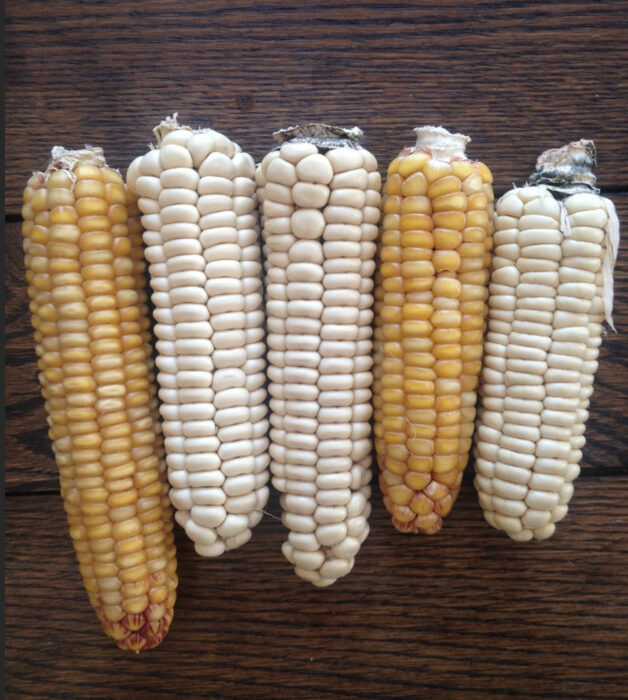
The Haudenosaunee were some of the most advanced First Nations in their agricultural techniques and practices. So it is appropriate there is corn named in honour of that work—Iroquois White Corn. White corn has been grown for approximately 1400 years but was widely seen during the 17th century.
“Despite its abundance and its reputation as a staple of First Nations diet, the Iroquois White Corn was close to extinction following a dispute with the French over the Fur Trade. At the time, over 500,000 bushels worth of the corn was burnt down by the Europeans. Despite this loss, the First Nations saved seeds from the corn and continued to grow it not only for their sustenance but also for their heritage,” said Rebecca Dragusin on seeds.ca.
The corn was grown in a Three Sisters formation. When planted together, the Three Sisters — corn, beans, and squash — work to help one another thrive and survive. The Haudenosaunee used and continue to use corn as a food source to create soups and stews, cornbread and other foods. These three crops have been the centre of many Indigenous agriculture and culinary traditions. A diet of corn, beans, and squash is complete and balanced.
Corn provides carbohydrates and the dried beans are rich in protein and have amino acids absent from corn according to nativeseeds.org. Squash provides different vitamins and minerals than corn and beans. These three crops are also important because they can all be dried and used for food year-round. These traits are less important today but were important in the past which lead to their significance as the major cultivated foods.
“Corn provides tall stalks for the beans to climb so that they are not out-competed by sprawling squash vines,” states the site. “Beans provide nitrogen to fertilize the soil while also stabilizing the tall corn during heavy winds. Beans are nitrogen-fixers meaning they host rhizobia on their roots that can take nitrogen, a much-needed plant nutrient, from the air and convert it into forms that can be absorbed by plant roots. The large leaves of squash plants shade the ground which helps retain soil moisture and prevent weeds.”
The tradition of calling these crops the “Three Sisters” originated with the Haudenosaunee, who occupy the regions around the Great Lake in Canada and the northeastern United States. All three types of seeds are planted together in the same mound in the Haudenosaunee planting method. The elevated mound assists with drainage and avoids waterlogging of the plant roots which is important in this region that receives abundant rainfall in the summer.
White corn often cannot be grown to the heights and sizes of commercial yellow corn, which means it must be picked all by hand — a lengthy process that is only the beginning of a long journey from field to plate.
“Each ear must also be de-husked by hand, hulled, roasted, and sometimes ground into cornmeal. It can sometimes take days to complete this process, making it far more complicated to turn into a meal than the simple canned corn one can buy at the store,” wrote Matthew Meltzer on matador network.com. “And for all that work, the end product doesn’t provide a gloriously sweet reward. White corn is more like hominy than yellow corn and has an earthy, nutty flavour. Typically it’s used in soups, salads, and vegetable medleys. White corn flour can also be used to make mash, masa, and some bread.”
Food can be used to assist in connecting back to one’s culture. It is no different to many on Six Nations who are familiar with White corn and its history, like Laura Hill who wrote about her father Sagoyesatha, who has been planting white corn on his family’s land on Sour Springs Road for roughly 40 years on Six Nations of the Grand River Territory.
He returned to Six Nations in 1976, making the move from Buffalo to be closer to family and the community where he spent most of his childhood. Upon his return, he was given Tuscarora Longcob Chief seed from a relative. He planted it, watched it turn into a seedling, and then into a tall, towering stalk. Sagoyesatha saved the seed that year, as he does every year.
“Something that he tells me is an act of resistance. A form of protest against some of the more aggressive forms of industrial agriculture that our society has come to know,” said Hill.
Hill shared how Sagoyesatha came to grow Mother Corn — Etnoha Oneha — medicine corn that was traditionally used in ceremony for children who had lost their parents at a young age.
“They say one cob in every 100 will be Mother Corn,” he shares. After several seasons of growing corn, he peeled back the husks to find one – a single beautiful kernel at the end of the cob, surrounded by seven rows of kernels.
“To me, it symbolizes one person in the middle, consoled by a circle of others offering support, holding them up.” He adds “I also see Mother Corn as a symbolic message from Mother Earth – if we reconcile our lost relationship with the natural world, our grief and pain as a whole can be changed.” Growing corn to him is a healing process. A cultural reclamation. A reconnection journey.
“They almost lost this seed in the ‘50s and ‘60s. There was a shortage, and they only had enough for ceremonies. People had to go to other communities to find it. But luckily people kept growing what little was left, and we still have them today.”
Sagoyesatha is a residential school survivor, the significance of his role now as a cultivator of the very food that has sustained Haudenosaunee culture since the beginning is apparent. This is more than hobby gardening. It is a story of tenacity and survival – not just for the seed that was near lost, but for him too.






